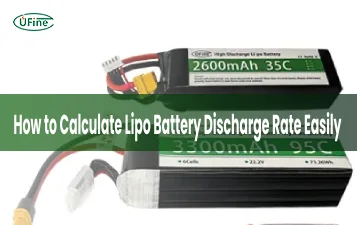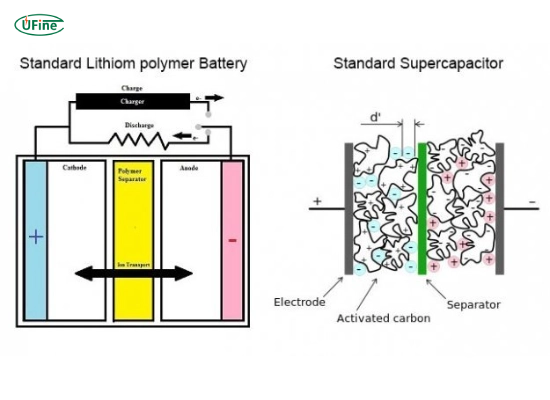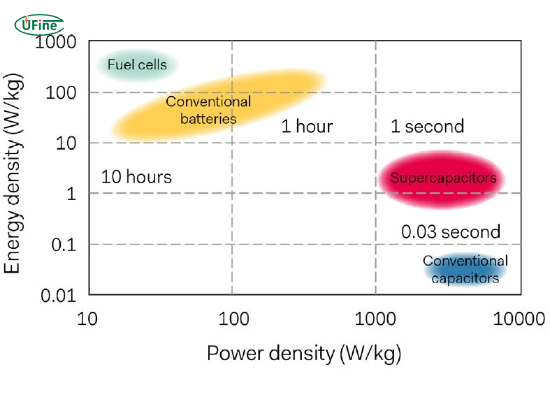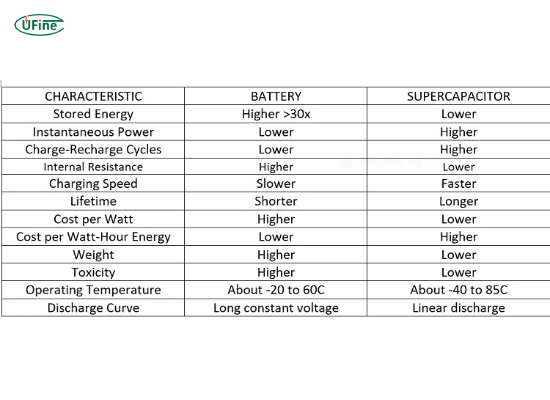Supercapacitors and lithium-ion batteries are leading technologies in energy storage. Supercapacitors excel in rapid charging and high power delivery, while lithium-ion batteries are known for their high energy density and long-term storage. This article compares these technologies to help you understand their unique features and applications.
Part 1. What are supercapacitors?
Supercapacitors, or ultracapacitors, are energy storage devices that store energy through electrostatic fields. Unlike traditional batteries, which rely on electrochemical reactions, supercapacitors use physical charge separation to store energy. This allows them to charge and discharge much faster than conventional batteries.
How do supercapacitors work?
Supercapacitors consist of two conductive plates separated by an electrolyte. When a voltage is applied, ions in the electrolyte move to the opposite charged plates, creating an electric double layer. This physical separation of charge allows supercapacitors to store and release energy quickly, making them ideal for applications requiring rapid bursts of power.
Advantages of supercapacitors
- Fast Charging: Supercapacitors can be charged in seconds, making them highly efficient for applications requiring rapid energy storage.
- Long Lifespan: Supercapacitors offer a significantly longer lifespan than traditional batteries, and they can handle millions of charge/discharge cycles.
- High Power Output: They can deliver quick bursts of power, making them ideal for high-power applications.
Disadvantages of supercapacitors
- Lower Energy Density: Supercapacitors have a lower energy density than lithium-ion batteries, limiting their use in long-term energy storage applications.
- Higher Cost: The cost per watt-hour of supercapacitors is generally higher than that of lithium-ion batteries.
Part 2. What are lithium-ion batteries?
Lithium-ion batteries are rechargeable batteries that use lithium ions as the primary component of their electrochemistry. Due to their high energy density, long cycle life, and relatively low self-discharge rate, they are widely used in portable electronics, electric vehicles, and renewable energy systems.
How do lithium-ion batteries work?
Lithium-ion batteries move lithium ions from the negative to the positive electrode during discharge and back when charging. This movement occurs through an electrolyte. Lithium cobalt oxide (cathode) and graphite (anode) are the electrodes. The high energy density of lithium-ion batteries makes them suitable for long-term energy storage.
Advantages of lithium-ion batteries
- High Energy Density: Lithium-ion batteries can store a large amount of energy in a compact size, making them suitable for portable electronics and electric vehicles.
- Long Cycle Life: They offer a relatively long cycle life compared to other battery types, although not as long as supercapacitors.
- Low Self-Discharge: Lithium-ion batteries have a low self-discharge rate, meaning they retain their charge for extended periods when not in use.
Disadvantages of lithium-ion batteries
- Longer Charging Time: Lithium-ion batteries take longer to charge compared to supercapacitors.
- Shorter Lifespan: They have a shorter lifespan due to the limited number of charge/discharge cycles they can endure.
- Thermal Runaway: Lithium-ion batteries are prone to overheating and can catch fire if not managed properly.
Part 3. Critical differences between supercapacitors and lithium-ion batteries
1. Energy Density
- Supercapacitors have lower energy density than lithium-ion batteries, meaning they store less energy per unit of weight or volume. This makes them less suitable for applications requiring long-term energy storage.
- Lithium-ion batteries excel in energy density, making them ideal for applications requiring extended energy storage, such as smartphones, laptops, and electric vehicles.
2. Power Density
- Due to their high power density, supercapacitors can deliver energy quickly, making them suitable for applications like regenerative braking in electric vehicles.
- Lithium-ion batteries have good power density but can’t match supercapacitors’ rapid discharge rates. However, they provide enough power for most consumer electronics and electric vehicle applications that need steady power over extended periods.
3. Cycle Life
- Supercapacitors boast an impressive cycle life, enduring millions of charge-discharge cycles with minimal degradation. This makes them ideal for applications where users expect frequent cycling.
- Lithium-ion batteries have a moderate cycle life, typically lasting between 500 and 1,500 cycles, depending on usage and care. However, they degrade over time, which is a limitation in applications requiring frequent charging.
4. Charging Time
- One of the standout features of supercapacitors is their rapid charging time. They can be fully charged in minutes, if not seconds, making them highly advantageous in scenarios where quick energy replenishment is crucial.
- Lithium-ion batteries take longer to charge, often requiring several hours to reach total capacity. However, advancements in fast-charging technology are gradually reducing this time.
5. Temperature Tolerance
- Supercapacitors perform well across a wide temperature range, from -40°C to +65°C, maintaining functionality in extreme conditions.
- Lithium-ion batteries are sensitive to temperature extremes, and their performance degrades in cold or hot environments. Therefore, they require thermal management systems to operate efficiently in such conditions.
6. Cost Considerations
- Supercapacitors are generally more expensive upfront than lithium-ion batteries. However, their long lifespan and low maintenance costs can lead to long-term savings.
- Lithium-ion batteries have a lower initial cost but may incur higher long-term expenses due to their shorter lifespan and potential replacement needs.
7. Environmental Impact
- Supercapacitors are more environmentally friendly due to their longer lifespan and fewer toxic materials. They are also easier to recycle than lithium-ion batteries.
- Lithium-ion batteries pose environmental challenges due to the extraction of materials like cobalt and lithium, and they are more challenging to recycle. Efforts are ongoing to improve their sustainability.
8. Practical Applications
Supercapacitors are ideal for applications requiring quick bursts of energy and frequent cycling, such as:
- Regenerative braking systems
- Power backup for servers
- Energy harvesting in IoT devices
Lithium-ion batteries are suited for applications needing **long-term energy storage** and steady power, including:
- Portable electronics (smartphones, laptops)
- Electric vehicles
- Renewable energy storage systems
Part 4. FAQs
-
What is the main difference between supercapacitors and lithium-ion batteries?
The main difference lies in their energy storage mechanisms. Supercapacitors store energy through electrostatic fields, allowing for rapid charging and discharging. In contrast, lithium-ion batteries store energy through electrochemical reactions, providing higher energy density but slower charging times. -
Can supercapacitors replace lithium-ion batteries?
Supercapacitors and lithium-ion batteries serve different purposes. Supercapacitors are ideal for applications requiring quick bursts of power, while lithium-ion batteries are better suited for long-term energy storage. They complement rather than replace each other. -
Are supercapacitors safer than lithium-ion batteries?
Experts generally consider supercapacitors safer because they do not suffer from thermal runaway. This condition can cause lithium-ion batteries to overheat and potentially catch fire. -
What are the typical applications of supercapacitors?
Manufacturers commonly use supercapacitors in regenerative braking systems, backup power supplies, and applications requiring high power output, such as specific industrial and automotive systems. -
How long do lithium-ion batteries last?
The lifespan of lithium-ion batteries typically ranges from 500 to 1,000 charge/discharge cycles, depending on factors such as depth of discharge, temperature, and usage patterns.
Related Tags:
More Articles

LiPo Battery Discharge Rate Guide & Calculation Tips
Understand LiPo battery discharge rates, C-ratings, and how to calculate max current. Essential guide for RC, drones, and electronics users.
High‑Capacity 3S LiPo Batteries: 5000 mAh vs. 10000 mAh
Compare 3S LiPo 5000mAh vs 10000mAh batteries by weight, power, and use. Find the best fit for your drone, RC car, or boat setup.
Top 5 Applications for Small 3S LiPo Batteries
Small 3S LiPo batteries power drones, RC gear, wearables, and robotics with high energy and low weight. Making them ideal for compact electronics projects.
Building and Charging Your Own 3S LiPo Pack: A Step‑by‑Step Guide
Learn how to build, balance, and charge a 3S LiPo battery pack safely at home with this complete DIY guide for hobbyists and beginners.
How to Choose the Right LiPo Battery Plug Type?
Discover the best LiPo battery plug types, how to choose them, and expert tips for safe usage, soldering, and maintenance.






